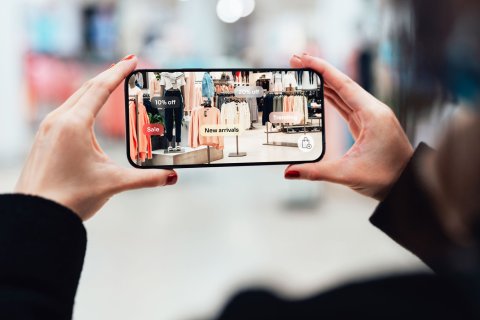
Augmented Reality Shakes Up Retail with Digital Makeup and Fashion

Augmented Reality (AR) is changing the way we shop, particularly how we buy clothes. Unlike virtual reality, in which you are immersed in an entirely simulated world, AR takes the real world and layers digital objects on top of it. For example, the Instagram filters that distort people’s appearance are considered AR, as is the IKEA mobile app that “places” furniture in your space. Nintendo’s Pokémon Go app, in which Pokémon appear to race around your real-world environment, may be the best known example.
Research by Deloitte and Snap Inc., the parent company of Snapchat, predicts that by 2025, 75% of the global population, including almost all smartphone users, will be frequent AR users. According to the Deloitte-Snapchat report, Gen Z and Millennials are both 71% more likely to use AR frequently than older people, in part because adoption has been driven by social media use. More than 300 million people already engage with AR every day on Snapchat.
Meghan Markle and Kate Middleton’s Style Staple That Nods to Jackie Kennedy
Now, Snap Inc. is betting big on AR in fashion: In 2021, it acquired Vertebrae, a company that helps brands like David’s Bridal, Herschel backpacks, and MOSCOT eyewear create 3D versions of their products. Retail experts say combining AR with social media like Snapchat may be the next big thing in retail. A survey done by McKinsey & Company shows 37 percent of fashion executives cite social commerce as one of the top three themes that will impact their business in 2022.
This year, Snap Inc. launched a new “Shopping Lens” feature, so Snapchatters can swipe through products from different retailers and ‘try’ them on. The first brands to use the feature are Ulta Beauty and MAC Cosmetics, but Snap says more are on the way. To use “Shopping Lenses,” a shopper simply looks into their smartphone’s camera and AR is applied in real time, using facial mapping and computer vision technology that create dynamic 3D visuals. Ulta’s GLAMlab, for example, applies 3D makeup to the user’s face, and the products move with the customer’s expressions as they would in real life.
A Snap Inc. spokesperson says one way AR may increase sales is by giving online shoppers the confidence to buy by showing them how a product is actually going to look on them, rather than relying on a picture of somebody else. Early research suggests try-on tools work: people are more likely to buy items after using the feature and less likely to return them. According to the National Retail Federation, $218 billion of online purchases were returned in 2021. Shopify reports a 40 percent decrease in returns among customers who had 3D visualization. AR researcher and author of Augmented Human: How Technology is Shaping the New Reality Helen Papagiannis, says, “Whether it’s viewing a product at full scale in 3D or inspecting the details of an item closer with AR, when customers are better informed, they are less likely to return products.”
Virtual Fitting Room Technology Launched for Walmart Shoppers
Vlad Vodolazov, Founder and CEO of virtual try-on clothing company Clo-Z, attributes the rise in AR retail to “a combination of the pandemic plus the metaverse; people started experimenting with using new ways to engage with their community. That helped us get more interest from conservative brands.”
In their 2021 trend report, consulting firm The Future Today Institute detailed the rising popularity of AR in fashion. “Some of the world’s best known designers have gotten wise to the virtual revolution,” the report says, citing Gucci’s AR partnerships which include a styling game called Drest, which allows users to try on hyper-realistic cosmetics tools, and an app called Sneaker Garage, where users can try on the brand’s virtual footwear. This February, Italian luxury brand Bottega Veneta, known for its daring marketing, launched its own AR app.
High fashion brands are also entering the space through gaming partnerships. In 2019, Louis Vuitton partnered with the League of Legends game, which had 180 million monthly active players as of February. Players can purchase Louis Vuitton designs as “Prestige Skins” for their avatars. The collaboration marks the first time one of the most popular games has worked with a high-end fashion brand. While players can only buy avatar skins via the game, LV also released a complementary line of real-life League of Legends apparel.
The next, quickly emerging step is real-life, three-dimensional digital clothing that can be seen only by people wearing AR glasses. The Future Today Institute says consumers may be more environmentally conscious when shopping for physical items if they have the freedom to express themselves virtually. The technical changes, however, are still significant. To be convincing, 3D garments need to mimic the way physical fabric falls and looks on a person’s body in changing conditions. Fabric simulation requires technology like Lidar (light detection and ranging) cameras, as well as the ability to track a person’s entire body and separate it from their environment.
This content was originally published here.


